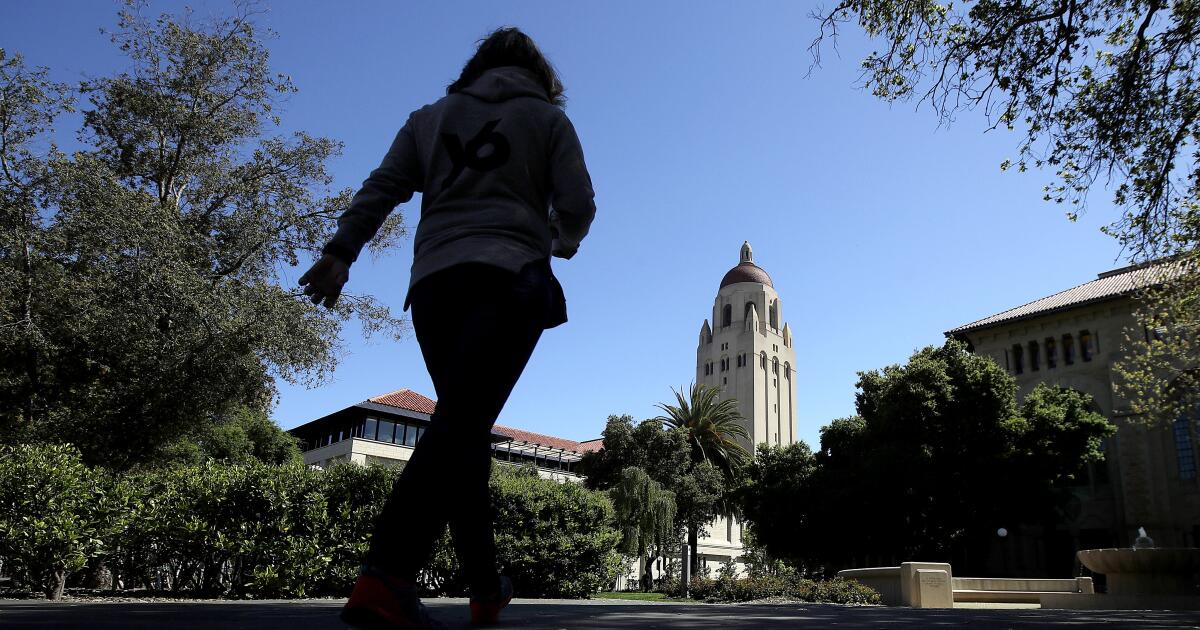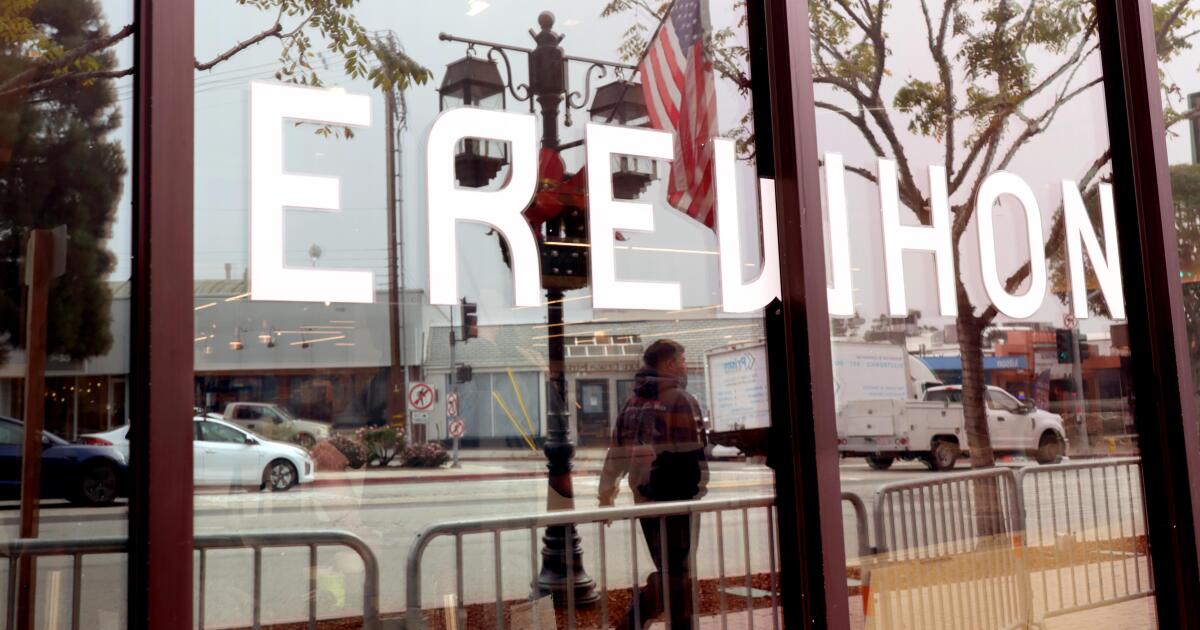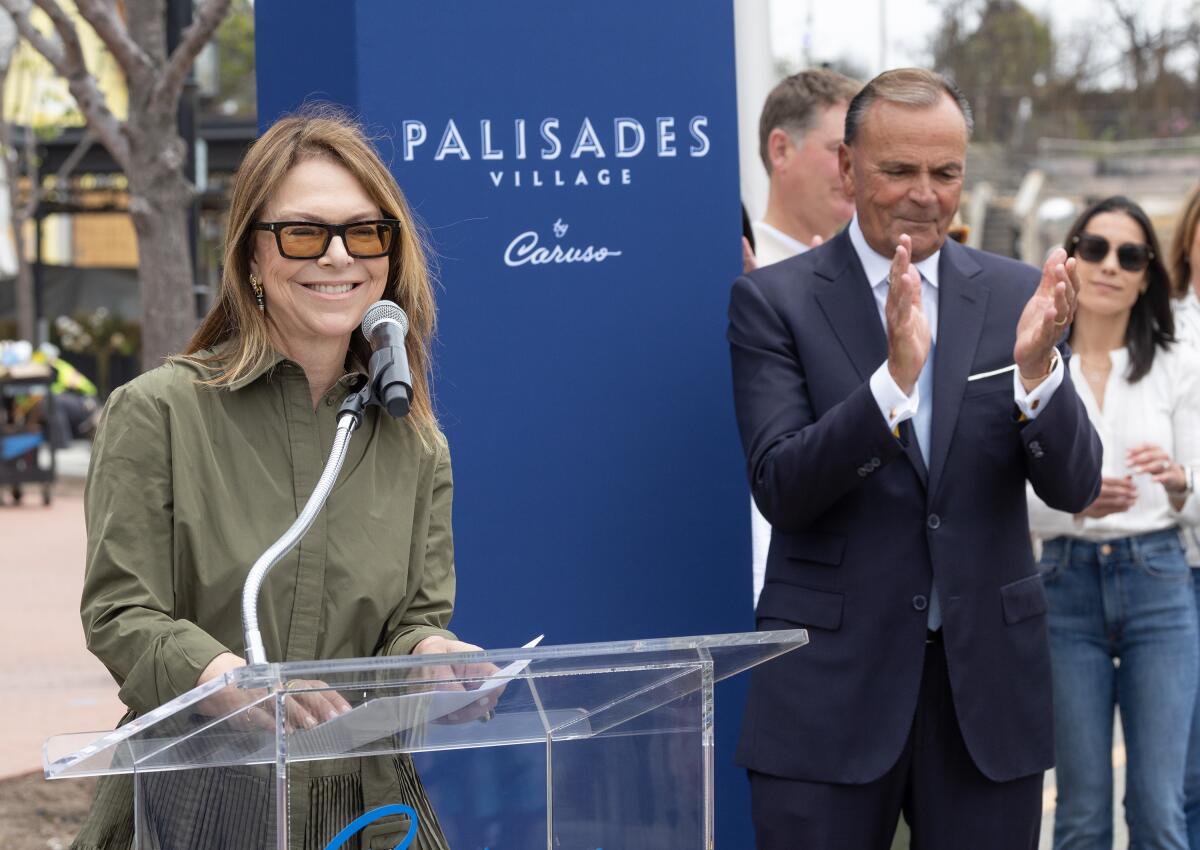Business
David Ellison is taking control of Paramount. Now the real work begins

Tech scion David Ellison battled hard to get Paramount Global.
The Skydance Media chief executive first made overtures last summer to Paramount’s nonexecutive chair, Shari Redstone, then spent months negotiating and renegotiating a deal acceptable to Redstone, Paramount’s board and the company’s shareholders.
Now that he’s clinched the company through a complicated, multipronged transaction valued at more than $8 billion, the real work begins. Ellison is set to become the company’s chief executive, while former NBCUniversal Chief Executive Jeff Shell will be president (Shell left his old job after acknowledging an “inappropriate relationship” with a colleague).
The legacy media and entertainment company has major challenges Ellison will need to address quickly to get Paramount back on the right footing, once the deal closes during the first half of next year.
Like many entertainment companies, Paramount is facing a decline in theatrical box office revenue as audiences haven’t returned to movie theaters with the same frequency as before the COVID-19 pandemic. Add to that Paramount’s particular woes with its money-losing streaming business as well as its heavy investment in cable networks that face challenges from cord cutting and declining advertising dollars, and it’s clear there is a lot for Ellison and his investors to fix.
“There really are amazing assets in this company,” said Jessica Reif Ehrlich, senior media and entertainment analyst at Bank of America Securities. “They just haven’t been managed well.”
For example, Paramount Pictures’ historic Melrose Avenue studio is valuable, as is Paramount’s broadcast network CBS. Some of the company’s cable networks, which include Nickelodeon, BET and MTV, have prized content and recognizable names. But they’re shells of what they used to be, Reif Ehrlich said.
“Every part of the business is under siege at this moment,” she said. “They really do need to resolve what they will be and have a clear point of view and way to achieve that as soon as possible.”
Paramount’s heavy debt load
First and foremost is paying down Paramount’s debt. Part of the company’s balance sheet problem will be addressed with a $1.5-billion cash infusion from Skydance and RedBird Capital Partners.
Getting Paramount on solid financial footing is key to its future success.
“This is very much about the fact that David Ellison and Skydance have had a 15-year relationship with Paramount,” RedBird Capital founder Gerry Cardinale said in an interview. “So it made it a lot easier to look at a strategic recapitalization, as opposed to just doing a deal.”
Paramount’s three current co-CEOs have already embarked on a $500-million cost-cutting plan that will continue as the Skydance transaction unspools. That plan involves evaluating the sale of certain Paramount assets, potentially including BET, as well as an unspecified number of layoffs. During an investor presentation Monday, Skydance executives said they had identified as much as $2 billion in “cost efficiencies” that would help increase cash flow.
Kenneth Leon, research director at CFRA Research, sounded cautiously optimistic about the plan in a note to investors.
“We think the new company has major opportunities for content production and distribution, but the challenges of competing in today’s disruptive movies and entertainment industry remain,” he wrote.
Cable networks: Asset and liability
It’s no secret that linear television revenue is declining as more customers cut the cord and abandon their traditional cable and satellite packages. But though the financial returns are diminishing, the cable networks are still making money for Paramount. That makes them an important asset to keep managing — strategically.
Last year, Paramount’s TV media segment, which includes CBS and the cable networks, brought in about $20 billion, or 68% of the company’s total revenue, according to its annual report. But that was about an 8% decrease compared with 2022.
Things were slightly better in the first fiscal quarter of 2024, when TV media brought in $5.2 billion in revenue, an increase of 0.7% compared with the same period a year ago.
“The linear business declining is not necessarily a bad story for Paramount,” said Laurent Yoon, senior analyst at Bernstein. “It’s already reflected in the stock price, and it’s not Paramount’s problem alone. There’s not much they can do. They just have to manage the decline.”
During Monday’s investor call, Skydance and RedBird executives touted the value and reach of CBS, noting that the network was a “driver” for the company.
The studio: A new shine on the crown jewel?
As one of Hollywood’s first studios, 112-year-old Paramount Pictures is the crown jewel of the company. That’s certainly how Sumner Redstone, Shari’s late father, saw it.
It has churned out such landmark films as “The Godfather,” “Chinatown” and “Breakfast at Tiffany’s,” while moving into the modern age with franchises like “Top Gun” and “Star Trek.” But the company’s studio business has been a mixed bag of late.
Paramount’s filmed entertainment segment, which includes Paramount Pictures, its animation arm, Nickelodeon Studios and Miramax, brought in about $3 billion in revenue last year, down 20% from the previous year, according to regulatory filings. For the three-month period ending March 31, Paramount’s filmed entertainment sector revenue totaled $605 million, up about 3% from last year.
In some respects, the studio is being hit by the same external forces battering the rest of the entertainment industry — the 2024 box office receipts are not reaching the levels they did last year and fall far short of pre-pandemic levels. But the studio’s creative strategy needs to be rethought, as well as film budgets, said Reif Ehrlich of Bank of America.
Rethinking the studio strategy means leaning into franchises, Shell said in an interview.
“In Hollywood, you really make money when you have big franchises and are able to monetize them, and they really have not done that very effectively at Paramount,” Shell said. “For example, there’s no ‘Top Gun’ theme park ride anywhere in the world.”
If the studio’s finances were optimized — meaning if it cut back on expenses — it could be a $3-billion to $4-billion business with a potential for a 10% to 15% margin, said Yoon of Bernstein.
“Paramount obviously has a great heritage when it comes to moviemaking,” he said. “It feels like they should do better, but they’re not. But it does have the potential to stabilize.”
Ellison also said the Skydance deal would bolster the combined company’s animation capabilities, allowing Paramount to expand its family entertainment business.
Paramount+: The struggles of streaming profitability
The foray into the streaming business has been a costly one for Paramount. The company was late to join the so-called streaming wars, lagging behind competitors Netflix and even Disney, and then spent heavily on the service.
Even so, the company is struggling to add subscribers, leading to about $2 billion in losses for Paramount+ since launch. In the first fiscal quarter of 2024, however, the company’s streaming division reported revenue of nearly $1.88 billion, up 24% compared with a year earlier. The segment’s quarterly loss was $287 million.
Ellison laid out a plan Monday for tech upgrades to the Paramount+ service, including improved ad technology and a better algorithmic recommendation engine that could help reduce subscriber churn and increase users’ time on the platform.
One option currently being explored by the company is a joint venture for the streaming service, Paramount executives have said. Having a partner could help Paramount turn a profit in streaming, Yoon said.
Such a partnership would not be unprecedented. In May, Warner Bros. Discovery and the Walt Disney Co. said they would join together to offer a new streaming bundle this summer that would allow subscribers to access Max, Disney+ and Hulu in the same deal. Separately, Disney, Warner Bros. and Fox are preparing to launch a streaming venture for sports.
“It’s generally believed at this point that Paramount+ could be profitable in 2025, but ‘profitable’ is relative,” Yoon said. “Is it a dollar or is it a billion? They need to make sure the margin increases.”

Business
They graduated from Stanford. Due to AI, they can’t find a job

A Stanford software engineering degree used to be a golden ticket. Artificial intelligence has devalued it to bronze, recent graduates say.
The elite students are shocked by the lack of job offers as they finish studies at what is often ranked as the top university in America.
When they were freshmen, ChatGPT hadn’t yet been released upon the world. Today, AI can code better than most humans.
Top tech companies just don’t need as many fresh graduates.
“Stanford computer science graduates are struggling to find entry-level jobs” with the most prominent tech brands, said Jan Liphardt, associate professor of bioengineering at Stanford University. “I think that’s crazy.”
While the rapidly advancing coding capabilities of generative AI have made experienced engineers more productive, they have also hobbled the job prospects of early-career software engineers.
Stanford students describe a suddenly skewed job market, where just a small slice of graduates — those considered “cracked engineers” who already have thick resumes building products and doing research — are getting the few good jobs, leaving everyone else to fight for scraps.
“There’s definitely a very dreary mood on campus,” said a recent computer science graduate who asked not to be named so they could speak freely. “People [who are] job hunting are very stressed out, and it’s very hard for them to actually secure jobs.”
The shake-up is being felt across California colleges, including UC Berkeley, USC and others. The job search has been even tougher for those with less prestigious degrees.
Eylul Akgul graduated last year with a degree in computer science from Loyola Marymount University. She wasn’t getting offers, so she went home to Turkey and got some experience at a startup. In May, she returned to the U.S., and still, she was “ghosted” by hundreds of employers.
“The industry for programmers is getting very oversaturated,” Akgul said.
The engineers’ most significant competitor is getting stronger by the day. When ChatGPT launched in 2022, it could only code for 30 seconds at a time. Today’s AI agents can code for hours, and do basic programming faster with fewer mistakes.
Data suggests that even though AI startups like OpenAI and Anthropic are hiring many people, it is not offsetting the decline in hiring elsewhere. Employment for specific groups, such as early-career software developers between the ages of 22 and 25 has declined by nearly 20% from its peak in late 2022, according to a Stanford study.
It wasn’t just software engineers, but also customer service and accounting jobs that were highly exposed to competition from AI. The Stanford study estimated that entry-level hiring for AI-exposed jobs declined 13% relative to less-exposed jobs such as nursing.
In the Los Angeles region, another study estimated that close to 200,000 jobs are exposed. Around 40% of tasks done by call center workers, editors and personal finance experts could be automated and done by AI, according to an AI Exposure Index curated by resume builder MyPerfectResume.
Many tech startups and titans have not been shy about broadcasting that they are cutting back on hiring plans as AI allows them to do more programming with fewer people.
Anthropic Chief Executive Dario Amodei said that 70% to 90% of the code for some products at his company is written by his company’s AI, called Claude. In May, he predicted that AI’s capabilities will increase until close to 50% of all entry-level white-collar jobs might be wiped out in five years.
A common sentiment from hiring managers is that where they previously needed ten engineers, they now only need “two skilled engineers and one of these LLM-based agents,” which can be just as productive, said Nenad Medvidović, a computer science professor at the University of Southern California.
“We don’t need the junior developers anymore,” said Amr Awadallah, CEO of Vectara, a Palo Alto-based AI startup. “The AI now can code better than the average junior developer that comes out of the best schools out there.”
To be sure, AI is still a long way from causing the extinction of software engineers. As AI handles structured, repetitive tasks, human engineers’ jobs are shifting toward oversight.
Today’s AIs are powerful but “jagged,” meaning they can excel at certain math problems yet still fail basic logic tests and aren’t consistent. One study found that AI tools made experienced developers 19% slower at work, as they spent more time reviewing code and fixing errors.
Students should focus on learning how to manage and check the work of AI as well as getting experience working with it, said John David N. Dionisio, a computer science professor at LMU.
Stanford students say they are arriving at the job market and finding a split in the road; capable AI engineers can find jobs, but basic, old-school computer science jobs are disappearing.
As they hit this surprise speed bump, some students are lowering their standards and joining companies they wouldn’t have considered before. Some are creating their own startups. A large group of frustrated grads are deciding to continue their studies to beef up their resumes and add more skills needed to compete with AI.
“If you look at the enrollment numbers in the past two years, they’ve skyrocketed for people wanting to do a fifth-year master’s,” the Stanford graduate said. “It’s a whole other year, a whole other cycle to do recruiting. I would say, half of my friends are still on campus doing their fifth-year master’s.”
After four months of searching, LMU graduate Akgul finally landed a technical lead job at a software consultancy in Los Angeles. At her new job, she uses AI coding tools, but she feels like she has to do the work of three developers.
Universities and students will have to rethink their curricula and majors to ensure that their four years of study prepare them for a world with AI.
“That’s been a dramatic reversal from three years ago, when all of my undergraduate mentees found great jobs at the companies around us,” Stanford’s Liphardt said. “That has changed.”
Business
Disney+ to be part of a streaming bundle in Middle East

Walt Disney Co. is expanding its presence in the Middle East, inking a deal with Saudi media conglomerate MBC Group and UAE firm Anghami to form a streaming bundle.
The bundle will allow customers in Bahrain, Kuwait, Oman, Qatar, Saudi Arabia and the UAE to access a trio of streaming services — Disney+; MBC Group’s Shahid, which carries Arabic originals, live sports and events; and Anghami’s OSN+, which carries Arabic productions as well as Hollywood content.
The trio bundle costs AED89.99 per month, which is the price of two of the streaming services.
“This deal reflects a shared ambition between Disney+, Shahid and the MBC Group to shape the future of entertainment in the Middle East, a region that is seeing dynamic growth in the sector,” Karl Holmes, senior vice president and general manager of Disney+ EMEA, said in a statement.
Disney has already indicated it plans to grow in the Middle East.
Earlier this year, the company announced it would be building a new theme park in Abu Dhabi in partnership with local firm Miral, which would provide the capital, construction resources and operational oversight. Under the terms of the agreement, Disney would oversee the parks’ design, license its intellectual property and provide “operational expertise,” as well as collect a royalty.
Disney executives said at the time that the decision to build in the Middle East was a way to reach new audiences who were too far from the company’s current hubs in the U.S., Europe and Asia.
Business
Erewhon and others shut by fire set to reopen in Pacific Palisades mall

Fancy grocer Erewhon will return to Pacific Palisades in an entirely rebuilt store, as the neighborhood’s luxury mall, owned by developer Rick Caruso, undergoes renovations for a reopening next August.
Palisades Village has been closed since the Jan. 7 wildfire destroyed much of the neighborhood. The outdoor mall survived the blaze but needed to be refurbished to eliminate contaminants that the fire could have spread, Caruso said.
The developer is spending $60 million to bring back Palisades Village, removing and replacing drywall from stores and restaurants. Dirt from the outdoor areas is also being replaced.
Demolition is complete and the tenants’ spaces are now being restored, Caruso said.
“It was not a requirement to do that from a scientific standpoint,” he said. “But it was important to me to be able to tell guests that the property is safe and clean.”
Erewhon’s store was taken down to the studs and is being reconfigured with a larger outdoor seating area for dining and events.
When it opens its doors sometime next year, it will be the only grocer in the heart of the fire-ravaged neighborhood.
The announcement of Erewhon’s comeback marks a milestone in the recovery of Pacific Palisades and signals renewed investment in restoring essential neighborhood services and supporting the community’s long-term economic health, Caruso said.
A photograph of the exterior of Erewhon in Pacific Palisades in 2024.
(Kailyn Brown/Los Angeles Times)
“They are one of the sexiest supermarkets in the world now and they are in high demand,” he said. “Their committing to reopening is a big statement on the future of the Palisades and their belief that it’s going to be back stronger than ever.”
Caruso previously attributed the mall’s survival to the hard work of private firefighters and the fire-resistant materials used in the mall’s construction. The $200-million shopping and dining center opened in 2018 with a movie theater and a roster of upmarket tenants, including Erewhon.
“We’re honored to join the incredible effort underway at Palisades Village,” Erewhon Chief Executive Tony Antoci said in a statement. “Reopening is a meaningful way for us to contribute to the healing and renewal of this neighborhood.”
Erewhon has cultivated a following of shoppers who visit daily to grab a prepared meal or one of its celebrity-backed $20 smoothies.
The privately held company doesn’t share financial figures, but has said its all-day cafes occupy roughly 30% of its floor space and serve 100,000 customers each week.
Erewhon has also branched out beyond selling groceries.
Its fast-growing private-label line now includes Erewhon-branded apparel, bags, candles, nutritional supplements and bath and body products.
Erewhon will also open new stores in West Hollywood in February, in Glendale in May and at Caruso’s The Lakes at Thousand Oaks mall in July 2026.
About 90% of the tenants are expected to return to the mall when it reopens, Caruso said, including restaurants Angelini Ristorante & Bar and Hank’s. Local chef Nancy Silverton has agreed to move in with a new Italian steakhouse called Spacca Tutto.
In May, Pacific Palisades-based fashion designer Elyse Walker said she would reopen her eponymous store in Palisades Village after losing her 25-year flagship location on Antioch Street in the inferno.

Fashion designer Elyse Walker announced the reopening of her flagship store at the Palisades Village in May.
(Myung J. Chun/Los Angeles Times)
“People who live in the Palisades don’t want to leave,” Walker said at the time. “It’s a magical place.”
Caruso carried on annual holiday traditions at Palisades Village this year, including the lighting of a 50-foot Christmas tree for hundreds of celebrants Dec. 5. On Sunday evening, leaders from the Chabad Jewish Community Center of Pacific Palisades gathered at the mall to light a towering menorah.
A total of 6,822 structures were destroyed in the Palisades fire, including more than 5,500 residences and 100 commercial businesses, according to the California Department of Forestry and Fire Protection.
Caruso said he hopes the shopping center’s revival will inspire residents to return. His investment “shows my belief that the community is coming back,” he said. “Next year is going to be huge.”
-

 Iowa5 days ago
Iowa5 days agoAddy Brown motivated to step up in Audi Crooks’ absence vs. UNI
-

 Iowa6 days ago
Iowa6 days agoHow much snow did Iowa get? See Iowa’s latest snowfall totals
-

 Maine3 days ago
Maine3 days agoElementary-aged student killed in school bus crash in southern Maine
-

 Maryland5 days ago
Maryland5 days agoFrigid temperatures to start the week in Maryland
-

 Technology1 week ago
Technology1 week agoThe Game Awards are losing their luster
-

 South Dakota5 days ago
South Dakota5 days agoNature: Snow in South Dakota
-

 Nebraska1 week ago
Nebraska1 week agoNebraska lands commitment from DL Jayden Travers adding to early Top 5 recruiting class
-

 Sports1 week ago
Sports1 week agoPro Football Hall of Famer Troy Aikman critiques NIL landscape, transfer rules and Lane Kiffin’s LSU move



















